
Use standard departure routes and channelized altitudes whenever practical to reduce coordination. Do not, however, assign these routes solely to provide for possible radar or communication failure.
Before departure, assign the initial heading to be flown if a departing aircraft is to be vectored immediately after takeoff.
PHRASEOLOGY -
FLY RUNWAY HEADING.
TURN LEFT/RIGHT, HEADING (degrees).
NOTE -
TERMINAL: A purpose for the heading is not necessary, since pilots
operating in a radar environment associate assigned headings with vectors
to their planned route of flight.
REFERENCE -
FAAO 7110.65, Departure Clearances, paragraph 4-3-2.
FAAO 7110.65, Vectors Below Minimum Altitude, paragraph 5-6-3.
5-8-3 Successive or Simultaneous Departures
TERMINAL
Separate aircraft departing from the same airport/heliport or
adjacent airports/heliports in accordance with the following minima provided
radar identification with the aircraft will be established within 1 mile
of the takeoff runway end/helipad and courses will diverge by 15 degrees
or more.
NOTE -
1 - FAAO 8260.19, Flight Procedures an Airspace, establishes guidelines
for IFR departure turning procedures which assumes a climb to 400 feet
above the airport elevation before a turn is commenced. FAAO 8260.3, TERPS,
the ILS missed approach criteria, requires a straight climb of 400 feet
be specified where turns greater than 15 degrees are required.
2 - Consider known aircraft performance characteristics when applying
initial separation to successive departing aircraft.
3 - When one or both of the departure surfaces is a helipad, use the
takeoff course of the helicopter as a reference, comparable to the centerline
of a runway and the helipad center as the threshold.
a. Between aircraft departing the same runway/helipad or parallel
runways/helicopter takeoff courses separated by less than 2,500 feet -
1 mile if courses diverge immediately after departure. (See Figure 5-8-1,
Figure 5-8-2, and Figure 5-8-3).
 |
 |
 |
{New-98-3 Revised February 26, 1998}
NOTE -
This procedure does not apply when a small aircraft is taking
off from an intersection on the same runway behind a
large aircraft or when an aircraft is departing behind a heavy
jet/B757.
REFERENCE -
FAAO 7110.65, Intersection Departure, paragraph 3-9-7.
FAAO 7110.65, Intersecting Runway Separation, paragraph 3-9-8.
FAAO 7110.65, Minima, paragraph 5-5-3.
b. Between aircraft departing from diverging runways:
1. Nonintersecting runways - Authorize simultaneous takeoffs
if runways diverge by 15 degrees or more. (See Figure 5-8-4).
 |
2. Intersecting runways and/or helicopter takeoff courses which
diverge by 15 degrees or more - Authorize takeoff of a succeeding aircraft
when the preceding aircraft has passed the point of runway and/or takeoff
course intersection. When applicable, apply the procedure in paragraph
3-9-5. (See Figure 5-8-5 and Figure 5-8-6).
 |
{New-98-3 Revised February 26, 1998}
NOTE -
This procedure does not apply when aircraft are departing behind
a heavy jet/B757.
c. Between aircraft departing in the same direction from parallel
runways/helicopter takeoff courses - Authorize simultaneous takeoffs if
the centerlines/takeoff courses are separated by at least 2,500 feet and
courses diverge by 15 degrees or more immediately after departure. (See
Figure 5-8-7 and Figure 5-8-8).
 |
 |
 |
TERMINAL
Except as provided in paragraph 5-8-5, separate a departing aircraft
from an arriving aircraft on final approach by a minimum of 2 miles if
separation will increase to a minimum of 3 miles (5 miles when 40 miles
or more from the antenna) within 1 minute after takeoff.
NOTE -
1 - This procedure permits a departing aircraft to be released so long
as an arriving aircraft is no closer than 2 miles from the runway at the
time. This separation is determined at the time the departing aircraft
commences takeoff roll.
2 - Consider the effect surface conditions, such as ice, snow, and
other precipitation may have on known aircraft performance characteristics,
and the influence these conditions may have on the pilot's ability to commence
takeoff roll in a timely manner.
5-8-5 Departures and Arrivals on Parallel or Nonintersecting Diverging Runways
TERMINAL
Authorize simultaneous operations between an aircraft departing
on a runway and an aircraft on final approach to another parallel or nonintersecting
diverging runway if the departure course diverges immediately by at least
30 degrees from the missed approach course until separation is applied
and provided one of the following conditions are met:
NOTE -
When one or both of the takeoff/landing surfaces is a helipad, consider
the helicopter takeoff course as the runway centerline and the helipad
center as the threshold.
a. When parallel runway thresholds are even, the runway centerlines
are at least 2,500 feet apart. (See Figure 5-8-9 and Figure 5-8-10).
 |
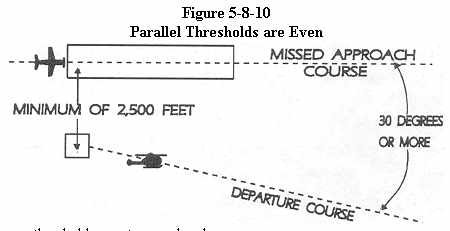 |
b. When parallel runway thresholds are staggered and:
1. The arriving aircraft is approaching the nearer runway -
The centerlines are at least 1,000 feet apart and the landing thresholds
are staggered at least 500 feet for each 100 feet less than 2,500 the centerlines
are separated. (See Figure 5-8-11 and Figure 5-8-12).
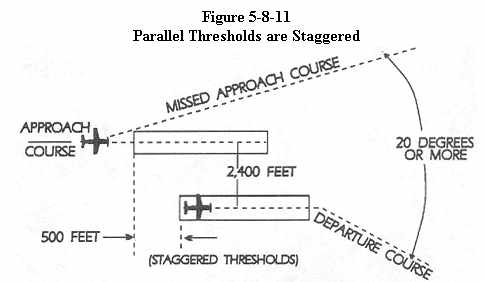 |
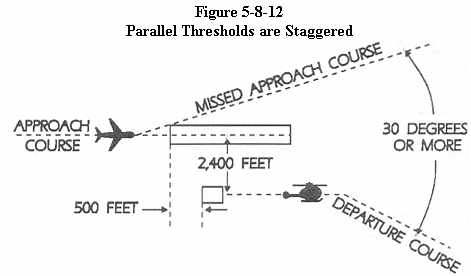 |
NOTE -
In the event of a missed approach by a heavy jet / B757, apply the
procedures in paragraph 3-9-6 or 3-9-8 or ensure that the heavy jet does
not overtake or cross in front of an aircraft departing from the adjacent
parallel runway.
2. The arriving aircraft is approaching the farther runway -
The runway centerlines separation exceeds 2,500 feet by at least 100 feet
for each 500 feet the landing thresholds are staggered. (See Figure 5-8-13).
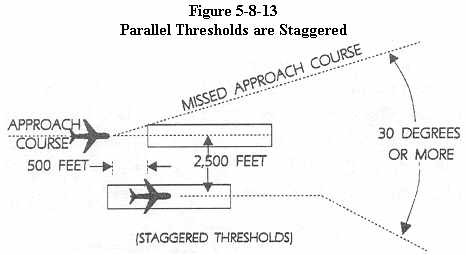 |
c. When nonintersecting runways diverge by 15 degrees or more
and runway edges do not touch. (See Figure 5-8-14).
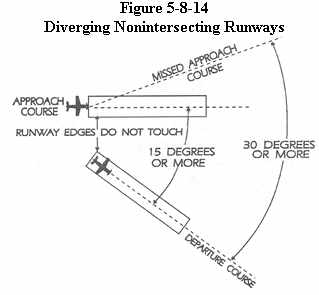 |
d. When the aircraft on takeoff is a helicopter, hold the helicopter until visual separation is possible or apply the separation criteria in subparagraphs a, b, or c.
REFERENCE -
FAAO 7110.65, Departure and Arrival, paragraph 5-8-4.